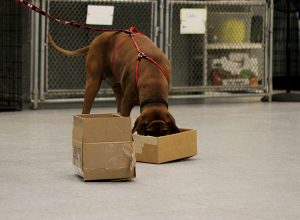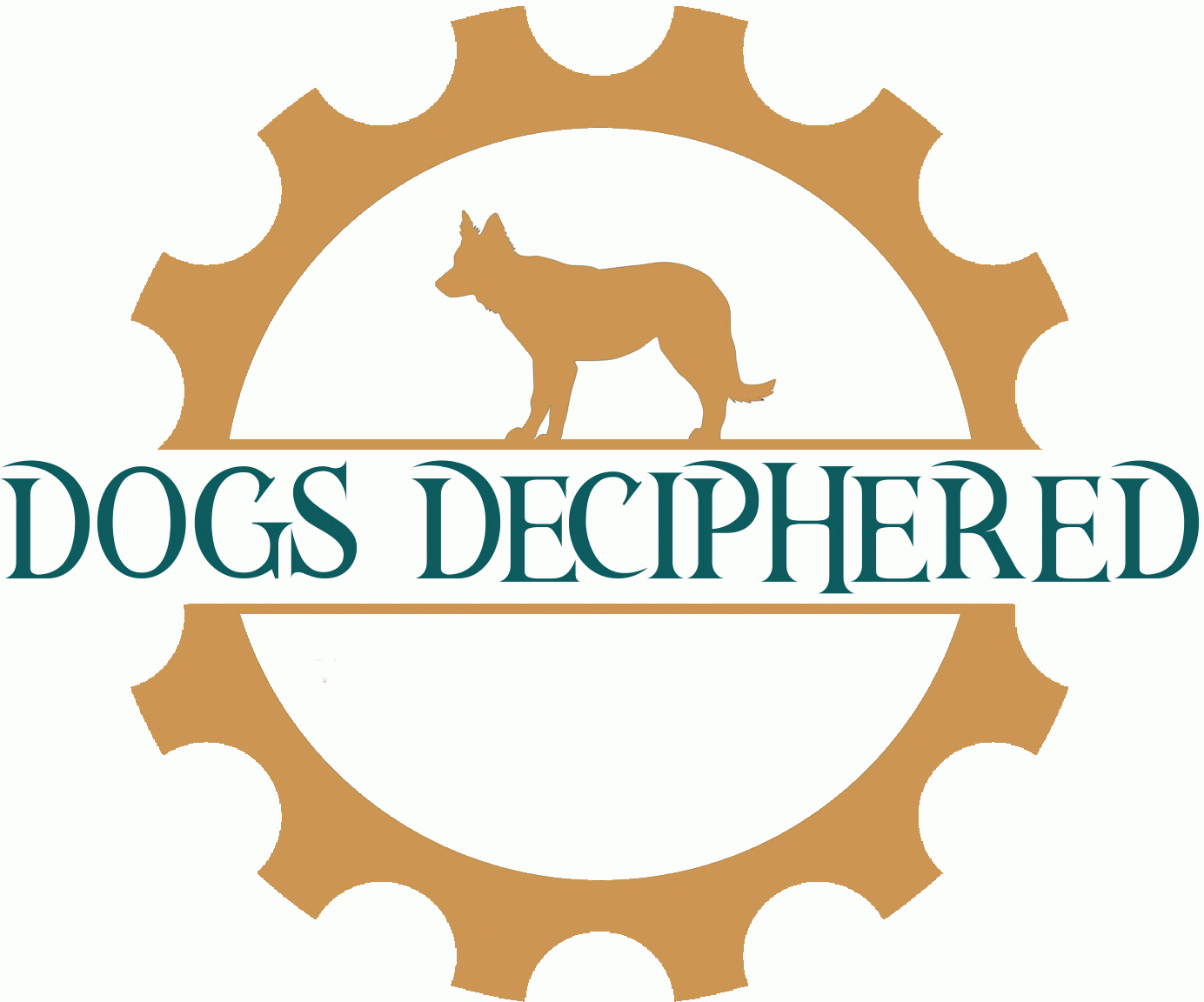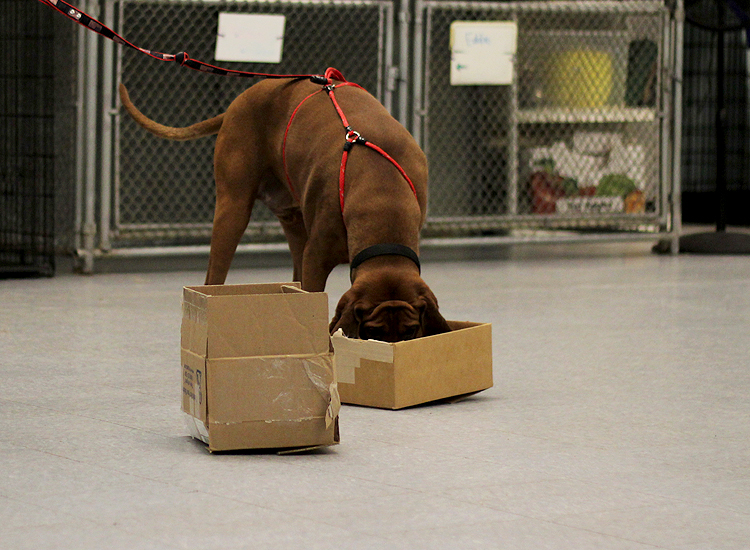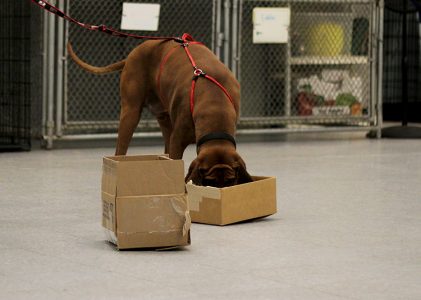I believe that it is in our dogs’ best interests to be encouraged to search for food in certain contexts. Let’s be clear, we are not teaching the dog to search for food, the dog is not learning to search for food, they come programmed for that. I am talking about setting up scenarios in which the dog comes to expect that they can find food, and will be allowed to do so. The most structured form of this is my K9 Nose Work® classes, where dogs start off searching for high value food in a variety of settings before eventually pairing that food with a target odor that dogs can learn to hunt for in expectation of a reward. In a much less formal way, I encourage my in-home training clients to stop helping their dog find tossed treats on the floor, but rather let the dog use his nose to find it on his own. It might be surprising that it would be difficult for a dog to find a treat on the floor, but when we continually step in and help the dog by pointing or tapping our toe, he’s learned a new strategy for food acquisition, looking to you for clues. More about that later, but let’s discuss why food searching matters.
Searching for food is instinctual – it’s primal. It’s still not completely understood how dogs came to partner up with humans, but there’s little doubt that there was food on the table (no pun intended!). One of the more popular theories of domestication, and the one I think is the most likely, is that certain wolves had low enough fear levels to approach groups of humans to get scraps of food items. Those groups stayed closer to humans than more fearful wolves and started diverging from the population. The friendlier they were toward humans, the higher the likelihood that the humans would allow them to stick around, and eventually get close enough to get better quality food. This would mean the very earliest ancestors of dogs were out searching for food one day and smelled a kill that a group of humans had made. They investigated a bit further, following their supreme olfactory senses toward the humans. Decision making time, is it worth going closer to the potentially scary humans to get an energetically low-cost meal, or carry on looking for prey that you then have to chase down and kill yourself? A few individuals were bold enough to follow their noses to a few scraps on the outskirts of the encampment, and they got a few easy calories, thus increasing their chance of survival. Seeking out food sources that don’t involve an energetically costly hunt is in dogs’ DNA, I would argue more so than any actual hunting ability for most pet dogs.
Anyone who has taken a K9 Nose Work® class, or even watched your dog stare up at you as you try to point out a piece of food you’ve dropped in the kitchen, has witnessed the dog’s incredible ability to use the human instead of his own senses. Most people don’t see it as incredible, they think the dog “doesn’t have a good nose” or “doesn’t get the game”, but from the dog’s point of view, why try at all when someone is going to step in and do all the work for you? They’ve taken this energetically low-cost food seeking to the extreme. That’s not a problem, except that a large majority of pet dogs are bored, and many exhibit disruptive and destructive behavior as a result of that, and their brains need more to do. Just because they’ve manipulated us into giving them all their food for free, does not mean that it is in their best interest! We have gotten to the point where we are so fully in control of our dog’s resources, when they eat, when they go out, what they play with, where they go, that dogs rarely get a chance to use the part of their brains that is designed to seek things out, sniff, and problem solve.
I strongly believe that allowing our dogs to engage these senses is the answer to a lot of our dog problems. I’ve seen incredible things from taking and teaching K9 Nose Work® classes, where the dogs are taught a foundation of searching for food (in some instances a toy, but only when that’s much more valuable to that dog than food). This taps into that instinctual drive to seek out food and builds on it in a way that challenges the dog’s mind to solve complex odor problems. This changes dog’s lives. In the very first nose work class I took, there was a tiny toy poodle who was afraid of the world. She was very inhibited, and on the first night of class she would not take food at all. Each time it was her turn, she would come out, the instructor and the owner would try a few variations of getting her to take a treat (from the owner’s hand, from the floor, etc.) and I don’t believe she took anything that first night. The next week she came back, and I remember her taking a treat of the edge of a box flap, and we all had to show enormous self-restraint in holding in our cheers so we didn’t scare her. By the time we work working outside (I would guess 8 weeks in or so), that same little dog was searching an entire pavilion of picnic tables searching for her piece of food. My two Border Collies, Pirate and Tori, were loving the sport by this point, but what really hooked me was the change I saw in that little poodle.

I have since recommended K9 Nose Work® classes to many of my clients’ whose dogs are struggling with a variety of behavioral issues from fearfulness, to reactivity toward dogs and people. Many of my fabulous colleagues recommend their clients to me for nose work classes as well. I have seen tremendous progress in these dogs, some of whom had been through lots of great behavior modification, but nose work seemed to be the thing that allowed them to start behaving more like a normal dog. There’s something almost magical that happens when a dog starts tuning out previous fears or concerns and gets lost in the search. By setting up a completely safe environment for the dog to search, they start to learn that more in the world is safe than they previously thought. They trust the game, and because we can create search areas almost anywhere, we can teach them to trust new environments, or new people, by incorporating them into the search.
For those who aren’t interested in attending K9 Nose Work classes, you’re crazy. Just kidding, but I really do think that any dog can benefit from being encouraged to search for food, and making it into a game that they can take on the road and play in other locations. I teach my clients the “Treat Toss Game” where you toss a treat a short distance away, and when the dog goes to get it, you call their name, and when they reorient back to you, you toss another treat in a different direction (Note: This is essentially the same as Leslie McDevitt’s Ping-Pong Game from her Pattern Games DVD, and it’s where I got the idea, I only changed the name in case I changed the game or the intent in any way!). Now, there are several uses for this simple game, including a great foundation for a recall, name response, and more, but my favorite part of this game is where the dog goes and chases down the treat. Eventually you can toss the treat farther and farther, and because of the success the dog has had at this game, she will more dedicatedly search for the treat. But, not if you help her! You have to build the game from a short distance where the dog can easily find the treat to a more difficult one where there is some searching involved. If you step in and help, you are denying your dog the benefits she can get from sniffing out the treat on her own. You can also set up multiple food searches for your dogs at home, like scattering kibble in the backyard, or hiding pieces of chicken around your living room for your dog to find. Just remember, your dog has a history of you helping him acquire food, so you must start off easy so that you never have to step in and help. If you help, you just reinforce your dog’s knowledge that it’s easier to look to you than to do it themselves, and the whole point is getting them to use their brains!
I was having a discussion with a friend with whom I trade yoga classes for nose work classes for her two dogs. One of her dogs is quite anxious, and we were discussing how much searching settled his mind. She suggested that it might be the increased oxygen he was getting to his brain from sniffing that helped him, just like when we do yoga, or any type of deep breathing exercises. While I have no evidence to support this idea, I think it’s a really good one. I have seen dogs who typically stress pant in new situations take a deep breath before starting a search, because panting isn’t conducive to bringing in odors. I think we could all benefit from breathing more deeply, as often as possible, and if searching helps dogs do that, I’m all for it.
I have become a total K9 Nose Work fanatic, but it’s truly because of the difference I have seen it make in so many dogs’ lives, and their owners’ lives in turn. It has totally changed the way I solve behavior problems in dogs, and changed the way I see my own dogs and dogs as a whole. If you aren’t incorporating searching for food into your dog’s life, I highly recommend you do. Get back to the roots of who dogs truly are and see what a difference it makes for your dog!


